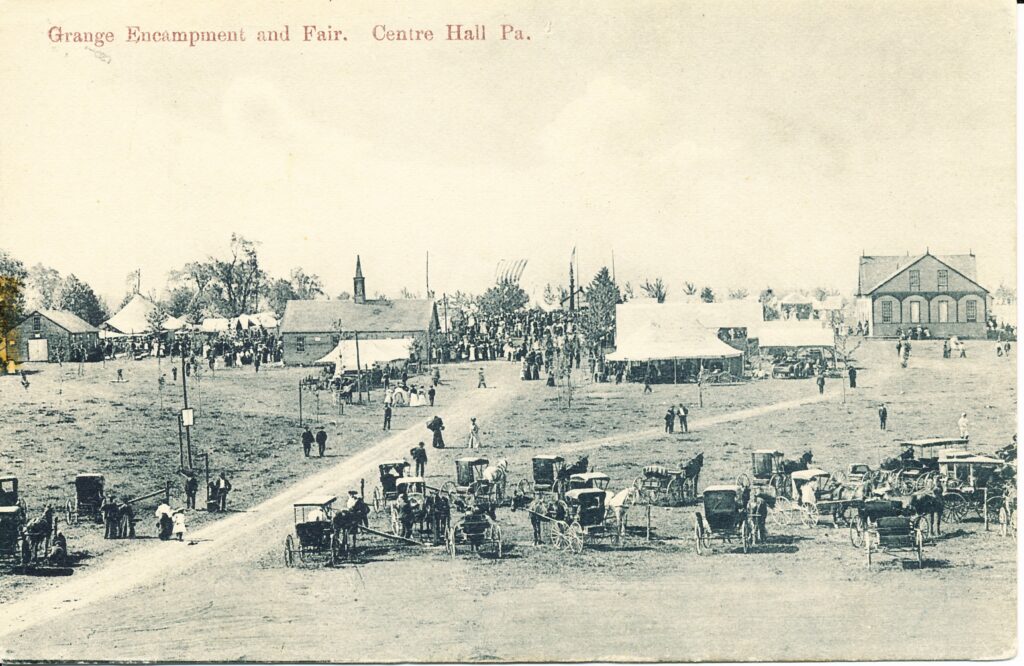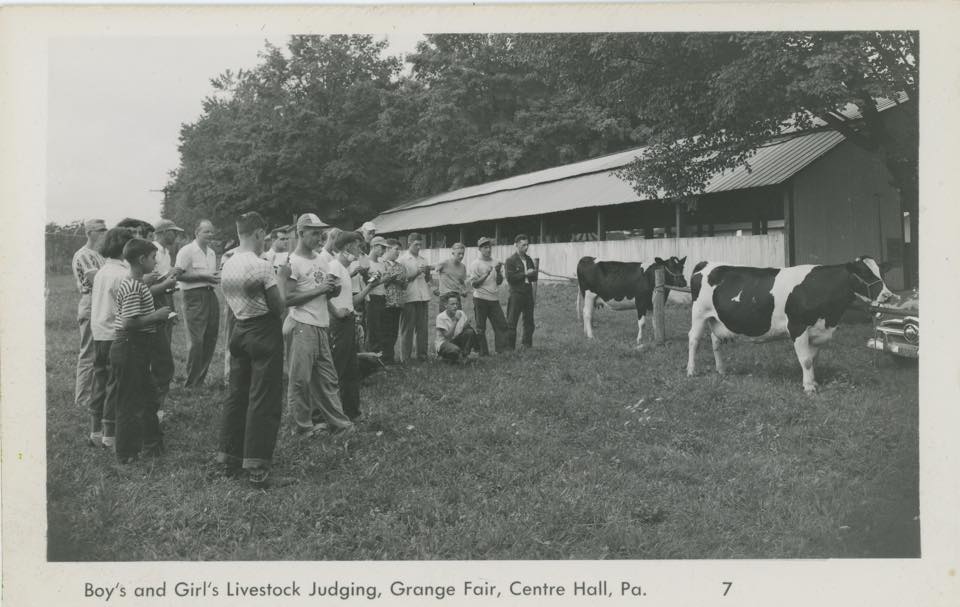The Centre County Grange Encampment and Fair, known popularly as the Grange Fair, is held each summer at Grange Park in Centre Hall. It is the last remaining tenting fair held in the U.S. Generations of local families have been attending the fair, many camping in the iconic canvas tents.
The first fair took place on September 24, 1874, in Leech’s Woods, near Centre Hall. Leonard Rhone organized the event and invited members of the local Granges to attend. About 3,000 people attended the event, which was called the “Granger’s Pic-nik.” The Centre Reporter noted that “eight or ten acres of the woodland were dotted with many hundreds of tablecloths and a feast was enjoyed by all.”
In 1890, the event moved to Grange Park, a 26-acre site in Centre Hall purchased by the Centre County Pomona Grange. Over time, the park grew to 264 acres. The organization now estimates that the park is home to about 1,000 tents and 1,500 recreational vehicles during the fair. The park also makes room for hundreds of concessions stands, 7,000 exhibit items, along with numerous amusement rides.

The fair originated as a local extension of the national Grange mission. In 1867, the Patrons of Husbandry, or Grange, organized as a national movement to improve the economic well-being of farmers, a group particularly hard hit by the aftermath of the Civil War and a later economic downturn. The Grange grew from local associations of farmers that met to discuss their problems and to seek solutions.
In Centre County, Rhone was a key supporter of the Grange’s local efforts. Besides organizing the Granger’s Pic-nik, he helped shepherd the creation of the Progress Grange. By 1874, sixteen local granges were established in Centre Hall.
In 1890, organizers created a permanent committee to oversee the fair. Committee members were responsible for the fairground layout, as well as prioritizing and scheduling improvements and additions, including road and fence construction, tent placement, and new buildings. By 1914, the county granges and various rural groups could appoint a committee member.
The use of tents and the inclusion of various exhibits were introduced to the fair in 1877. Initially, the Pennsylvania National Guard lent the organizers tents. Exhibits that year included pieces of farm machinery.
During the 20th century, the fair continued to expand. To meet the the increasing number of people who made the event an annual tradition, event officials needed to expand the park. In 1923, the park grew to about 70 acres after the Fair Board purchased an additional 45 acres.
The number of tents increased from 28 in 1877 to 200 in 1910. Tents also were more sophisticated. Once primitive Army-style shelters, many tents had a wooden floor, bench, table, and bunk. Several tents shared cook stoves and firewood. Small grocery stores were opened to provide campers with food during the long stay.
By 1916, the fair had entered the electric age. The midway and main street of the park were illuminated with a 75-watt light bulbs powered by a 12-kilowatt transformer. Most tents continued to rely on kerosene lamps, but eventually campers could rent a light bulb for a dollar.
The fair was equipped with electric lights before many surrounding homes and farms in Penns Valley. In fact, most of Centre Hall remaining without electricity until the 1930s when the Rural Electrification Act stirred projects that brought electric power to many rural areas. Public telephones were installed at the fair in 1928.
The fair persevered through wars and conflict, weather disasters, and economic upheavals. In 1890, the first year that the event was held in its expanded Grange Park, a series of rainstorms turned the newly cleared fairground into mud and caused tents to collapse. Yet, eventgoers continued to show up, confined mostly to a five-acre section that was adequately covered with roofs and canvas.

The fair continued through World War I and in the economic uncertainty that followed. Although the Great Depression sent waves of unrest and economic repercussions throughout the area, the fair economy was relatively unscathed. A general admission ticket for the week-long event cost 50 cents, the same price as before the Depression, and event organizers actually lowered the cost of automobile parking to 25 cents in 1933.
Even World War II thwarted but did not completely scuttle the event. The fair was cancelled in 1943, mainly due to gasoline rationing, but a one-day picnic was held instead. The 2020 event fell victim to the COVID-19 pandemic.
Agricultural demonstrations and livestock exhibits are the picnic’s major attractions, but livestock sales generate interest. They also generate significant income. In 1998, for example, 268 animals were sold, raising more than $120,000. In 1972, a Junior Livestock Sale allowed young people to show their livestock, win prizes, and earn money from sales.
The first amusement ride — the Wave — was introduced in 1915. The fair now features a Ferris wheel, swings, merry-go-rounds, and other rides.
Throughout the history of the fair, a variety of entertainers have performed at the event. While the performers represented a range of musical styles, the event earned a reputation of not just hosting top artists in country music, but in helping to break talent nationally. In 1990, Garth Brooks performed at the fair on his way to becoming a top act in country and pop music.
Matt Swayne
Source:
Lathbury, Norman K. Centre County Grange Fair and Encampment: A History of Master Rhone’s Pic-Nic. Centre Hall, PA: Centre Publications, 1999.
First Published: September 8, 2021
Last Modified: February 17, 2025
